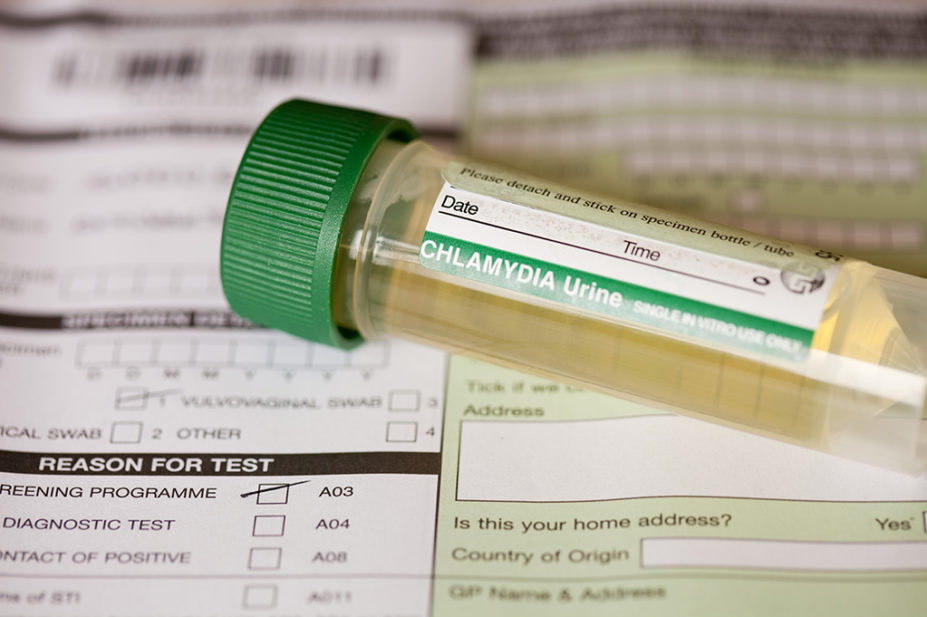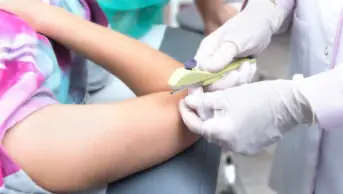
ASHLEY COOPER / SCIENCE PHOTO LIBRARY
After reading this article, you should be able to:
- Recognise the signs and symptoms of chlamydia, including complications of untreated infection;
- Understand who should be screened for chlamydia and how it is diagnosed;
- Know the evidence-based treatment recommendations to apply to your practice.
Introduction
Genital chlamydia infection is caused by the bacterium Chlamydia trachomatis and is the most common bacterial sexually transmitted infection in the UK. Approximately 70% of those affected are sexually active adults aged under 25 years[1]. Owing to its often asymptomatic presentation and high frequency of transmission (up to 78.6% of the partners of positive cases are also infected), effective screening programmes and prompt management of positive cases is imperative in preventing complications from untreated infections[2].
There are several known serovars (subtypes of a species of bacteria; also known as serotypes) linked with different presentations[3]:
- Serovars D-K cause urogenital infection;
- Serovars L1-L3 are more invasive and cause lymphogranuloma venereum (LGV), which most commonly results in anorectal symptoms.
LGV can cause irreversible scarring and swelling of the genitals, and long-term bowel complications[4].
Infection occurs primarily via vaginal, anal and oral penetrative sexual intercourse. Extragenital presentations affecting the eyes and throat are also seen. Untreated infections have been known to clear spontaneously, with up to 50% of cases resolving approximately 12 months from diagnosis[4].
Complications from untreated infections are diverse and can have a serious impact on the patient. Untreated chlamydia in women and other people with a womb or ovaries can cause pelvic inflammatory disease, which in turn can lead to chronic pain, ectopic pregnancy and/or infertility. Untreated chlamydia can also cause inflammation of the testicles (epididymitis), which can also affect fertility. Chlamydia is the most common cause of sexually acquired reactive arthritis in all patients[4].
Community pharmacies are well placed to provide screening and treatment services. In 2022, the Pharmaceutical Services Negotiating Committee published a template service specification to allow local pharmaceutical committees to develop their own services, tailored to the needs of their communities[5].
For the purposes of this article, the terms ‘male’, ‘female’, ‘men’ and ‘women’ should be read from the perspective of sex rather than gender and to include consideration of sex assigned at birth.
Signs and symptoms
Although chlamydia is asymptomatic at the time of diagnosis for 70% of women and 50% of men, it can have symptoms and these differ between men and women[6].
In women, symptoms include increased vaginal discharge, post-coital and intermenstrual bleeding, dysuria (pain on urination) and lower abdominal pain. Other signs can include mucopurulent cervicitis, pelvic tenderness and cervical motion tenderness[4].
In men, symptoms include urethral discharge and dysuria. Rectal infection can also cause discharge and discomfort. LGV is associated with tenesmus — an urge to pass stool despite bowels being empty — and rectal discharge that can be bloody. Diarrhoea and altered bowel habit can also occur. For extragenital presentations, pharyngeal infections are usually asymptomatic but can lead to secondary oral infections. Conjunctival infection most commonly causes low-grade irritation in one eye, bilateral presentations are occasionally seen in both eyes[4].
Risk factors
Risk factors for infection include being aged under 25 years old, having a new sexual partner, having more than one sexual partner in the past year, and a lack of consistent condom use[4].
Screening and diagnosis
The English National Chlamydia Screening Programme recommends that all sexually active people with a womb or ovaries aged under 25 years of age who access a sexual and reproductive health service or contraceptive service, termination of pregnancy service, or GP or pharmacy for any reason should be offered a chlamydia test[7]. Further tests should be offered at partner change, or annually if their partner does not change.
Three-monthly sexually transmitted infection (STI) testing, which includes HIV testing, is recommended for certain high-risk groups, such as those having unprotected anal intercourse with partners of unknown HIV status in the past 12 months[8].
Nucleic acid amplification tests (NAAT) are the gold standard for diagnosing chlamydia, for which the specimen of choice is vulvo-vaginal swabs in women and first-catch urine in men[4]. Self-sampled rectal and pharyngeal swabs are recommended in men who have sex with men[8]. In symptomatic men, all sexual contacts within four weeks prior to onset of symptoms should be notified. In women and asymptomatic men, all sexual partners within the past six months should be informed[4].
Pharmacists should encourage sexual health checks for sexually active patients presenting with any symptoms suggestive of chlamydia, including LGV, such as rectal discharge.
Management
Chlamydia can be easily treated most commonly with the antibiotic doxycycline[9].
Doxycycline (preferred first-line treatment)
The recommended doxycycline dose and course by the British Association for Sexual Health and HIV (BASHH) is 100mg twice daily for seven days[4]. If LGV is suspected, particularly with rectal symptoms and a positive chlamydia result, a longer course of three weeks may be given pending LGV results. To reduce the risk of oesophageal ulceration, the capsules should be taken with a large glass of water while the patient is either sitting or in a standing position and well before retiring at night[10]. Photosensitivity has been observed in individuals taking doxycycline and can manifest as an exaggerated sunburn reaction[10]. Patients likely to be exposed to direct sunlight or UV light should be advised to discontinue treatment at the first evidence of skin erythema[10].
Other possible side effects include gastrointestinal disturbances, such as nausea, vomiting and diarrhoea. Antacids and other medicines containing aluminium, calcium, magnesium, zinc and iron or bismuth preparations may impair the absorption of doxycycline[10]. Indigestion remedies or medicines containing iron or zinc should be avoided two hours before or after taking doxycycline[11]. Doxycycline is contraindicated in pregnancy and when breastfeeding, largely because of the effect of tetracyclines on teeth and skeletal development[10].
Azithromycin (second-line treatment)
Azithromycin is recommended as a second-line treatment for chlamydia when doxycycline is contraindicated, for example in pregnancy. It is also recommended for the treatment of chlamydia with a gonorrhoea co-infection that is being treated with ceftriaxone and azithromycin. It should be taken on an empty stomach one hour before or two hours after food, initially 1g orally as a single dose and then 500mg once daily for two days[12]. Co-administration with antacids may affect the absorption of azithromycin, therefore azithromycin must be taken at least one hour before or two hours after antacids. Electrolyte disturbances can predispose patients to getting QT interval prolongation while taking azithromycin[12,13]. Possible side effects include dizziness, gastrointestinal disorders, headache, insomnia and taste alterations[12].
Alternative regimens
If either doxycycline or azithromycin are contraindicated, alternative antibiotics that can be used are erythromycin or ofloxacin. The recommended course of erythromycin is 500mg twice daily for 10–14 days or 500mg four times daily for 7 days[4]. The recommended course of ofloxacin is 200mg twice daily or 400mg once daily for 7 days[4].
If there is no response to first-line treatment, patients should be referred to their nearest sexual health clinic[14].
Test of cure
Test of cure (re-testing after a course of treatment) is not routinely recommended for chlamydia. This is because residual, non-viable chlamydial DNA can be detected for up to three to five weeks following treatment[4]. Test of cures is recommended in the following situations: in pregnancy; where poor compliance is suspected and where symptoms persist; and for asymptomatic HIV-negative men who have sex with men with rectal chlamydia (unless an LGV test has been performed and is negative)[4].
Considerations in special groups
Doxycycline is contraindicated in pregnancy owing to effects on teeth and skeletal development, and ofloxacin is not recommended in pregnancy owing to studies showing damage to the joint cartilage in immature animals[4,10,13]. The recommended treatment is either azithromycin, erythromycin or amoxicillin[4]. Treating pregnant women usually prevents transmission of C. trachomatis to neonates during birth[15]. People living with HIV should receive the same treatment as those who are HIV-negative[16].
It is worth noting that all the antibiotics mentioned can exacerbate muscle weakness in patients with myasthenia gravis and should be used with caution.
Resistance
Until 2018, most sexual health guidelines recommended either single-dose azithromycin (SDA) or doxycycline. A meta-analysis and a Cochrane systematic review determined that treatment failure among men was higher for azithromycin than for doxycycline[16,17]. Mycoplasma genitalium (MGen) is emerging as a significant STI, with reported chlamydia coinfection rates of 3–15%[15]. Recent data demonstrate an increasing prevalence of macrolide resistance in MGen, probably owing to the widespread use of SDA to treat STIs and the limited availability of diagnostic tests for MGen[15]. This has important implications for treatment, as undertreated rectal chlamydia infection may contribute to re-infection rates.
SDA has the potential to select for macrolide resistance in MGen and, as a result, it is inadequate as a treatment for rectal CT. BASHH no longer recommends SDA for treatment of uncomplicated chlamydia infection at any site, regardless of the sex of the infected individual[4].
Patient counselling points
- Ensure patients understand what chlamydia infection is and how it can be transmitted:
- It is a sexually transmitted infection;
- If asymptomatic, there is a chance that that it could have persisted for months or years.
- Explain the potential complications of leaving a chlamydia infection untreated;
- Explain the importance of complying fully with treatment and what to do if a dose is missed. As with any antibiotic treatment, patients should be advised to space the doses evenly throughout the day and to keep taking their medicine until the course is finished, unless told to stop[11];
- Strongly encourage partner notification and treat current partner(s) to reduce the risk of re-infection and onward transmission[14]. All patients identified with chlamydia should have partner notification discussed at the time of diagnosis by a trained healthcare professional. For patients apprehensive about partner contact, signpost to advice and supporting resources;
- Make sure each partner identified and the method for contact is documented;
- Partners should be advised that the window period for a chlamydia test is two weeks; therefore, a result will not show as positive unless at least two weeks have passed since their last sexual exposure, even if transmission has occurred. Pharmacists may be able to play a vital role in emphasising the importance of encouraging patients to notify partners;
- Sexual intercourse (including oral sex) should be avoided until the patient and their partner(s) have completed treatment (or waited seven days after treatment with azithromycin)[14];
- Signpost sexually active, symptomatic patients to a sexual health clinic as they may be eligible for additional services, such as hepatitis B screening, vaccinations and HIV pre-exposure prophylaxis;
- Provide advice on safer sexual practices, including advice on correct, consistent condom use;
- Ensure literature around sexual health, testing and treatment is available in your pharmacy.
Patient prognosis
Chlamydia is the most commonly reported curable bacterial sexually transmitted disease in the UK and most patients make a full recovery with no lasting complications. Having multiple chlamydial infections increases a woman’s risk of serious reproductive health complications, including pelvic inflammatory disease and ectopic pregnancy[15].
- 1Chlamydia: Surveillance, Data, Screening and Management. UK Health Security Agency. 2022.https://www.gov.uk/government/collections/chlamydia-surveillance-data-screening-and-management (accessed Feb 2023).
- 2Schillinger JA, Katz BP, Markowitz LE, et al. Genotype-Specific Concordance of Chlamydia trachomatis Genital Infection Within Heterosexual Partnerships. Sexual Trans Dis. 2016;43:741–9. doi:10.1097/olq.0000000000000525
- 3de Vries HJ, Zingoni A, White JA, et al. 2013 European Guideline on the management of proctitis, proctocolitis and enteritis caused by sexually transmissible pathogens. Int J STD AIDS. 2013;25:465–74. doi:10.1177/0956462413516100
- 4Nwokolo NC, Dragovic B, Patel S, et al. 2015 UK national guideline for the management of infection with Chlamydia trachomatis. Int J STD AIDS. 2015;27:251–67. doi:10.1177/0956462415615443
- 5Chlamydia Screening and Treatment. Pharmaceutical Services Negotiating Committee. 2022.https://psnc.org.uk/lpcs-and-local/locally-commissioned-services/en14-chlamydia-screening-treatment/ (accessed Feb 2023).
- 6Facts About Chlamydia. European Centre for Disease Prevention and Control. 2023.https://www.ecdc.europa.eu/en/chlamydia/facts (accessed Feb 2023).
- 7National Chlamydia Screening Programme. UK Health Security Agency. 2022.https://www.gov.uk/government/collections/national-chlamydia-screening-programme-ncsp (accessed Feb 2023).
- 8CEG Guidance on Tests for Sexually Transmitted Infections. British Association for Sexual Health and HIV. 2015.https://www.bashhguidelines.org/media/1084/sti-testing-tables-2015-dec-update-4.pdf (accessed Feb 2023).
- 9Chlamydia. NHS. https://www.nhs.uk/conditions/chlamydia/treatment/ (accessed Feb 2023).
- 10Doxycycline 100mg capsules: summary of product characteristics. Electronic Medicines Compendium. 2021.https://www.medicines.org.uk/emc/product/13082 (accessed Feb 2023).
- 11Scenario: Management of Uncomplicated Genital Chlamydia. National Institute for Health and Care Excellence. 2022.https://cks.nice.org.uk/topics/chlamydia-uncomplicated-genital/management/management/ (accessed Feb 2023).
- 12Azithromycin. British National Formular: Joint Formulary Committee. https://www.medicinescomplete.com/#/content/bnf/_734084339 (accessed Feb 2023).
- 13Azithromycin 250mg Film-Coated Tablets: summary of product characteristics. Electronic Medicines Compendium. https://www.medicines.org.uk/emc/product/2272/smpc (accessed Feb 2023).
- 14Doxycycline. Joint Formulary Committee: British National Formulary. https://www.medicinescomplete.com/#/content/bnf/_655034401 (accessed Feb 2023).
- 15Chlamydia Treatment and Care. Centers for Disease Control and Prevention. 2021.https://www.cdc.gov/std/chlamydia/treatment.htm (accessed Feb 2023).
- 16Paez-Canro C, Martinez-Martinez F, Alzate JP, et al. Antibiotics for treating genital chlamydia trachomatis infection in men and non-pregnant women. Cochrane Database of Systematic Reviews. 2013. doi:10.1002/14651858.cd010871
- 17Kong FYS, Tabrizi SN, Law M, et al. Azithromycin Versus Doxycycline for the Treatment of Genital Chlamydia Infection: A Meta-analysis of Randomized Controlled Trials. Clinical Infectious Diseases. 2014;59:193–205. doi:10.1093/cid/ciu220


